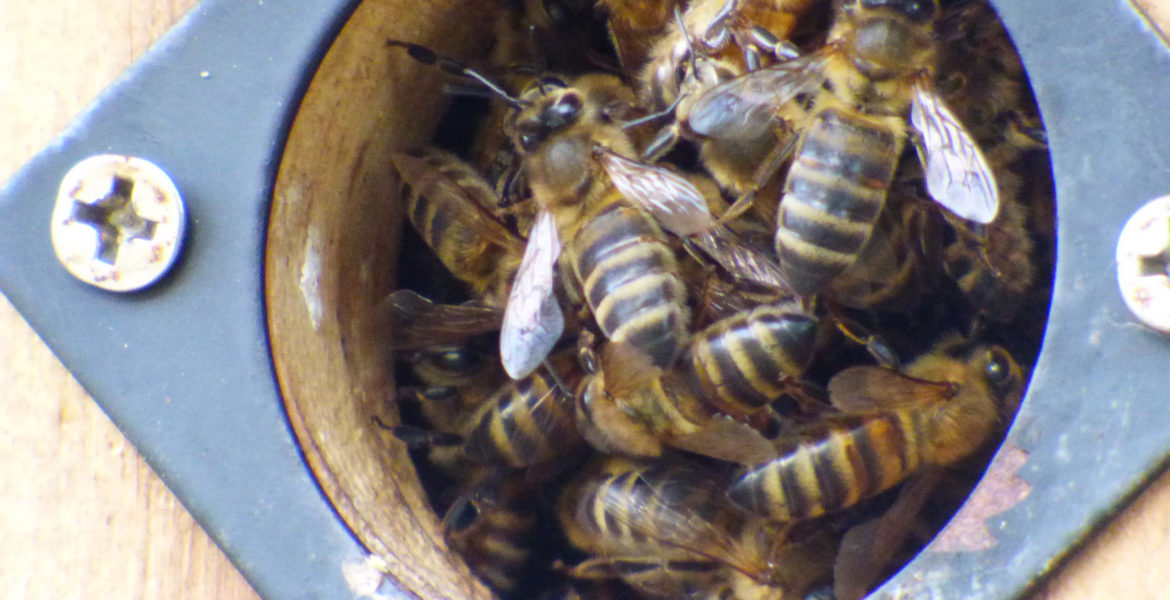What do you do when bees move into the birdhouse on the patio?
Beekeeper Dael Wilcox responds to bee emergencies all over Southern California, removing and relocating swarms and rehoming colonies. He has rescued bees from almost everywhere imaginable, sometimes having to improvise creative ways to reach colonies in walls, chimneys, and the tops of trees, so a birdhouse posed no difficulties.
He happened to be in the area working with Westside school children on a bee education project when he got the call about the birdhouse and arrived that evening with one of several hive boxes built and decorated by his young students.
“The teacher was looking to connect the students with the community,” he explained. “Teaching them to build the hives, in addition to learning about bees was a way to do that,” he said. The students will receive updates on the hives and their inhabitants as part of the program.
Although the birdhouse bees had only been in the birdhouse for a few days, they had already constructed three combs and were busy filling them with honey and pollen.
Wilcox explained that bees can swarm any time of year, but early spring is the most common time. A swarm is generated when a colony has reached its maximum size and needs to divide. The old queen leaves the hive, taking workers and honey with her to establish a new hive.
Swarming honeybees can look and sound alarming—the concentrated buzzing of hundreds of bees sounds eerily like the hum of electricity, but swarms are reportedly seldom aggressive. The University of California Agriculture and Natural Resources website describes them as “extremely docile,” and states that “It takes quite a bit of stimulation, such as being hit by sticks and stones or squirted with a hose, to induce defensive behavior.”
Wilcox concurred, adding that in his experience, the more unpredictable Africanized honeybee is uncommon in the Santa Monica Mountains. Still, it’s a good idea to keep children, pets, and anyone with a bee allergy indoors during swarming activity and at a safe distance from wild bee colonies.
Los Angeles County West Vector Control’s website offers practical advice on bee encounters: “If you accidentally encounter bees, do not panic, but remain calm and quietly retreat until the bees are out of sight. If forced to run, use your arms and hands to protect your face and eyes from possible stings. Quickly take shelter in a car or building. Water or thick brush does not offer adequate protection. Do not disturb or tease bees, and do not try to remove bees yourself. Do not shoot at, spray water at, throw rocks at, or douse bee colonies with chemicals. This will only irritate the bees. Also, do not attempt to control bees with aerosol pesticides.”
With bee populations in trouble worldwide, the best solution is live removal. A beekeeper like Wilcox will relocate a swarm for a fee that is usually based on how difficult it is to access the bees. The Messenger contacted several bee removal services and found the price for a simple removal runs between $50 and $200.
Relocating an established hive can be a much more complicated and costly issue. Wilcox shared images of a hive removal that required making a hole in the homeowner’s ceiling to safely remove the hive. The best way to avoid a bee crisis is to “bee proof” before a swarm decides to move in.
Checking to make sure vents, chimneys, and other openings—even small ones like knotholes in wooden siding, or the openings around pipes or utility boxes are screened with hardware cloth—can prevent a host of unwelcome occupants, including bees.
Wilcox explained that bees will usually seek an elevated hive site with a defensible opening, but almost any place can be repurposed for a beehive, including exposed tree branches, the tops of pine trees, BBQ grills, and children’s play houses. Wilcox recently relocated a hive housed in an old empty whiskey barrel.
The Messenger learned that bird boxes, especially the larger variety designed for hawks and owls, frequently attract bees. Mounting the box on a pole rather than in a tree may help discourage insect interlopers.
If a wild hive is far enough from human activity and no one in the immediate vicinity has an allergy, coexistence can be the best option. However, once a hive is established, the bees can become more aggressive. The birdhouse hive, located just a few feet from a frequently used patio, was too close for comfortable coexistence.
Before moving the colony, Wilcox carefully stocked the new hive box with several frames of comb full of honey to give the bees a source of food while they acclimate. Wearing a bee hood and jacket, but with bare hands, he gently shook the bees into the new hive, scooping out the comb and the stragglers by hand.
“Evening is an ideal time.” he explained. “The bees are in the hive for the night and they’re less active.”
This hive will be traveling up to the Central Valley for spring almond blossom season, before returning to Los Angeles to a permanent home with a beekeeper who lost her hives during the Sylmar Creek Fire in December.
Wilcox is located in Riverside County, but travels all over the southland, rescuing bees, teaching urban beekeeping, and selling his honey at local farmers markets, including the Friday Venice Market. He can be reached at www.B11Rescue.com or (951) 534-4727.
For information or advice from Vector Control, including live bee removal referrals, call (.310) 915-7370 or visit https://www.glacvcd.org.
The University of California Agriculture and Natural Resources website offers extensive information on bees at http://ipm.ucanr.edu/PMG/PESTNOTES/pn74159.html.

